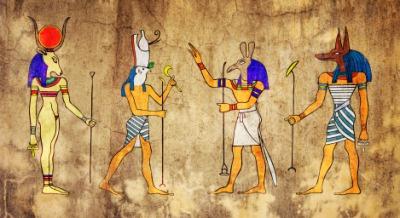A characteristic feature of Egyptian mythology is the deification of animals, as evidenced by the images of gods that have come down to our time, most of them are painted as a man with the head of a beast, less often a bird. This is precisely the proof of the deep archaic character of the Egyptian mythology.

The myths of ancient Egypt have their roots in primitive totemism, which in its original form was not a religion. It was a perfect belief in the identity of community members with individuals of a certain type of animals that could not stand the slightest doubt. The myths and tales of Ancient Egypt also originally arose without any connection with religion. It was a completely independent line of evolution of one sphere of the spiritual life of primitive people, which much later intersected with a line of religious beliefs that seriously affected it. The myths of ancient Egypt changed not only over time, but also with the change of the ruling dynasties. It was the supreme rulers who raised the first roles of the deities who patronized them. So, the pharaohs of the V dynasty elevated the supreme deity of Ra - the God of the sun, because they came from Heliopolis - the "city of the Sun." And in the period of the Middle Kingdom, God Amon was held in high esteem, after which, from the 3rd millennium BC. e. Osiris, the God of the Dead, began to play a paramount role.

Creation according to Egyptian mythology
Studying the most ancient myths of Ancient Egypt, you can find out another curious version of the creation of the world. At first, traditionally, the world was a bottomless gloomy abyss of Nun. After that, out of the primordial chaos came the Gods, who already created heaven and earth, plants and animals, people. This is a special merit of the god Khnum, who, according to legend, created the world from simple clay on a potter's wheel. He is portrayed as a man, but with the head of a ram. And from the unprecedented beauty of the lotus flower , the God of the sun Ra appeared, who with his face illuminated the whole earth. That is why a significant cycle of legends is devoted to the relentless and ongoing struggle of the forces of Darkness and the Sun. One myth tells of the battle of the sun god Ra and the treacherous serpent Apop, who reigned in the underworld until Ra defeated him in a deadly battle.
Pantheon of the Gods of Ancient Egypt
Amon Ra - the God of the sun - was depicted in human form, in a crown and with a scepter in his hand, as well as invariably with two feathers. Anubis - the patron saint of the dead - was portrayed as a man, but with the head of a jackal. Apis - the God of fertility - had the guise of a bull with a solar disk, but Aton was considered the personification of the solar disk. Geb, the son of the god of air, was the god of the earth, and Horus was the powerful God of heaven and sun. Min is the patron saint of crops, the God of fertility. God Nun - the lord of the water element, together with his wife Naunet were the first-born Gods who gave life to all others.

Osiris - the God of the underworld, the judge of the kingdom of the dead - was considered the patron of agriculture, grapes and wine, however, as well as absolutely all the vital forces and processes of nature. He was considered the “resurrecting and dying” God, thus personifying the change of seasons. The creator god Ptah was the patron of arts and crafts. Sebek was portrayed as a man with the head of a crocodile, he was the
god of water and the Nile. The personification of the evil principle, fratricide, the God of the desert - Set - was treacherous and vile. The moon god Thoth was considered the patron of sciences, wisdom, he was considered the creator of the calendar. God Khonsu was revered as the patron saint of travelers. A complete list of the gods can be compiled by spending not a dozen years studying various sources containing the myths of Ancient Egypt; an essay, however, can be written by reading the text of this article.